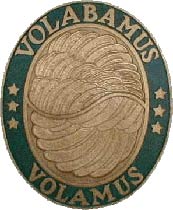Lieutenant Emile Chourré, Date & Location Unknown (Source: SDAM)
 |
According to ancestry.com, Lieutenant Emile Chourré, USNR, was born August 28, 1894 in San Francisco, CA to a French father, Pierre (b. December, 1867), and mother, Marianne M. Mausegne. The 1900 U.S. Census has Pierre (adopting the name "Peter" in the Census) living as head of household at 2317 Railroad Avenue, Alhambra, CA (presently an industrial area according to the aerial view at Google Earth). His occupation was recorded as "Laundryman." Pierre/Peter was 32 years old when the Census was taken June 9th. He had been in the United States since 1887 and was a naturalized citizen.
Pierre had two sons living with him, Jules (adopting the name "Julius" in the Census), age 8, and Emile, age 6. Two lodgers, aged 28 and 30, dwelled in the same address. Both lodgers were "Laundrymen." Emile and Jules were listed as "At School." Marianne was not living at the same location.
Regardless, and of further interest, the 1910 U.S. Census, collected on April 22, 1910, lists Emile (age 15) and brother Jules (age 17) as "inmates" of the International Order of Odd Fellows Orphan's Home in Santa Clara County, CA. They were listed among 42 other orphans living at the same facility. There is no indication of what happened to either Pierre or Marianne. If you can help fill in the blanks, please let me KNOW.
Seven years later, as of December 14, 1917, Emile was enlisted in the Navy. The 1920 U.S. Census captured him living at the Naval Station at Coco Solo, Panama Canal Zone. He was listed as an "Officer;" 25 years old. His enlistment happened in a matter of six months after he completed his draft registration on June 5, 1917. His draft registration card is below.
Emile Chourré Draft Registration Card, June 5, 1917 (Source: ancestry.com)
 |
Of interest is the fact that he was recorded, on the right side of his registration form, as having broken arches and a crippled hand. These handicaps couldn't have been significant, since he became an established flier for the U.S. Navy, piloting some of the Navy's largest amphibious and transport aircraft of the day.
Emile Chourré landed twice at Tucson. His first landing was on Monday, August 19, 1929. Carrying five unidentified mechanics, he flew the Navy Sikorsky XPS-2 A-8090. Based at San Diego, CA aboard the U.S.S. Saratoga, he arrived amidst nineteen other naval aviators, each signed into the Register on the middle third of page 112. Other than the first six who signed their own names, the rest were entered by an unknown hand all at once. Please direct your browser to the link and review page 112. There you'll see that signers Chourré through Wick comprise the group of twenty. They all remained overnight at Tucson, departing the morning of the 20th for El Paso, TX.
What were twenty Navy pilots doing at Tucson all at once? They were on a grand cross-country flight headed from San Diego to Cleveland, OH and back to participate in the National Air Races (NAR) held August 24th-September 2nd at Cleveland that year. Lt. Cdr. Homer Wick was commanding officer of Squadron No. 1 based on the Saratoga.
Wick brought his entire squadron through Tucson on behalf of the NAR. During the 1920s and 1930s, the Navy ordered numerous activities by its personnel, ships and airplanes to build confidence in the naval force among the U.S. citizenry, to provide real-life training for personnel, as well as to encourage recruitment.
Chourré's job was to support Wick's squadron, nine of whom were the aerobatic team named the "Nine High Hats." Please direct your browser to Wick's page to see a tabulation and identification of all the men in his squadron.
We are fortunate to have access to documents and photographs that Chourré collected and saved in scrapbooks to commemorate this cross-country trip. Below, from Chourré's (The Emile Chourré Photograph & Document Collection at the link), are some of the members of the aerobatic team, tabulated at Wick's link, standing in front of one of their aircraft with Charles Lindbergh (in the suit, second from right). This photograph is from Chourré's scrapbook covering the 1929 National Air Races. It is an original photograph, with original signatures in ink.
O'Beirne, Kivette, Lindbergh, Gehres, NAR, 1929 (Source: GL)
 |
Another original is the letter, below. It was written between midnight and 2:00AM Monday, August 26, 1929. Although the year is not written on the letter, or does it appear on the envelope (see below), it is 1929, because it mentions the people in the photograph above. Page one of the letter follows. His letter references, "... 2 shots a day at the mike and an occasional extra period over the national broadcasting chain." This is in reference to Chourré's other duty as announcer for the Navy aerobatic team as they performed. A full description, as well as photographs, are at the Photograph & Document Collection linked above.
Emile Chourré, Letter to Family, Page 1, August 26, 1929 (Source: GL)
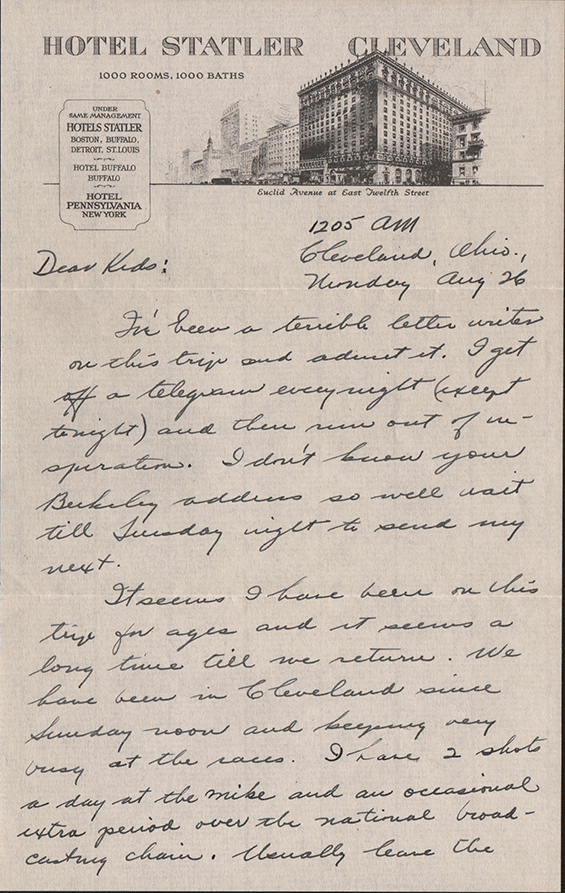 |
Two articles appeared in the news (undated and unsourced) that give an idea of his public relations obligation for the Navy. These clippings were enclosed in the envelope containing this letter, but referenced speaking engagements in San Diego. Regardless, they represent the kind of activity Chourré performed.
Emile Chourré Public Speaking in Cleveland (Source: GL)
 |
Page two follows. His position as public relations for the Navy Team got him invitations to dinner with aviation bigwigs of the era. Loening and Emsco were the names of Golden Age aircraft manufacturers. Note that Mr. Fisher was a director of the Bank of Italy based in Los Angeles.
Emile Chourré, Letter to Family, Page 2, August 26, 1929 (Source: GL)
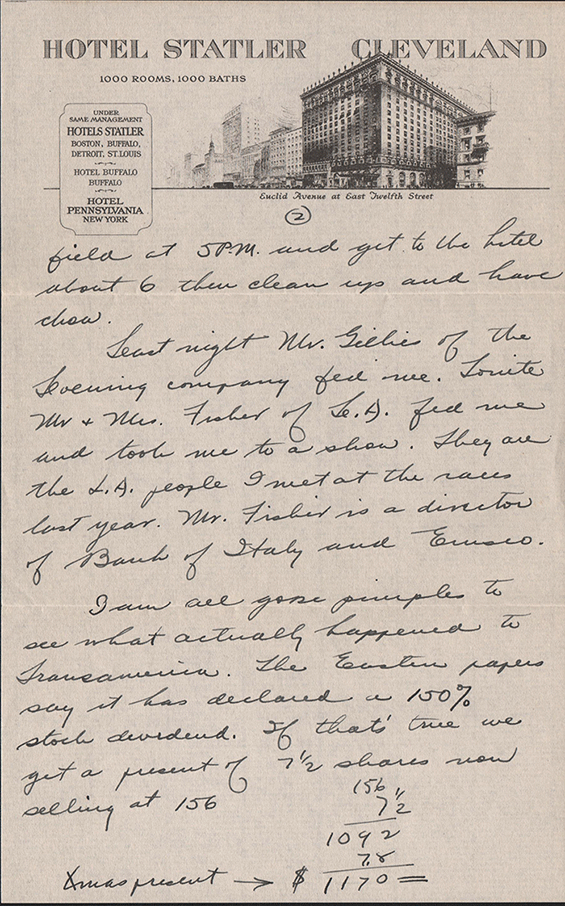 |
Historical juxtaposition makes page 2 of this letter very interesting. First, he last paragraph references a stock dividend predicted for Transamerica Corporation. Transamerica started in 1904 as a financial services company in San Francisco. That year its founder created the Bank of Italy in San Francisco. In 1928 it merged with the Bank of America and formed Transamerica, a new company in August, 1929. I'm sure Fisher and Chourré had lots to talk about at dinner. Second, Chourré had only two months to enjoy his "goose pimples." The stock market would crash in October, kicking off the Great Depression. We can only hope he sold his Transamerica before October 28th. Page 3 follows.
Emile Chourré, Letter to Family, Page 3, August 26, 1929 (Source: GL)
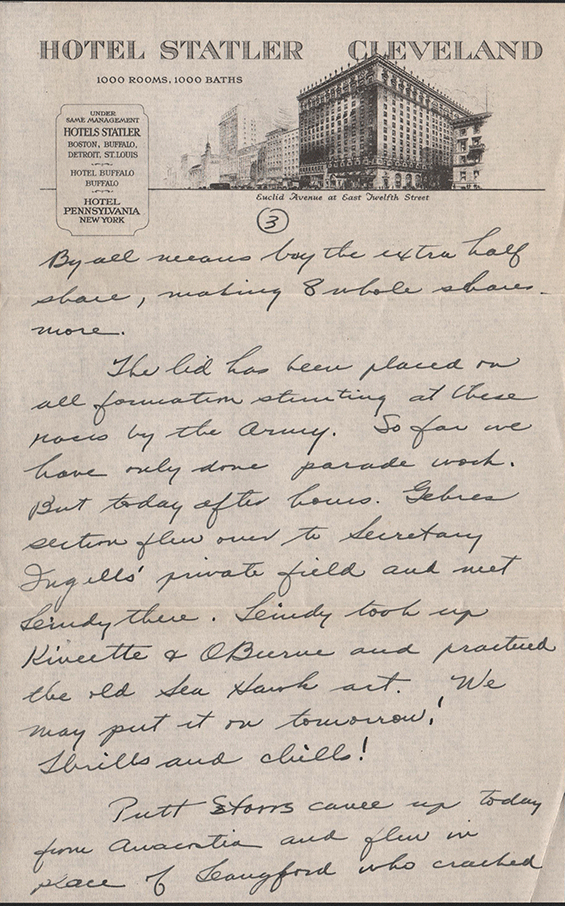 |
This is the page that ties the letter to the photograph above. All four of the flyers mentioned in the letter are posed in the photo. The Three Sea Hawks act is further described at the link. Page 4 follows.
Emile Chourré, Letter to Family, Page 4, August 26, 1929 (Source: GL)
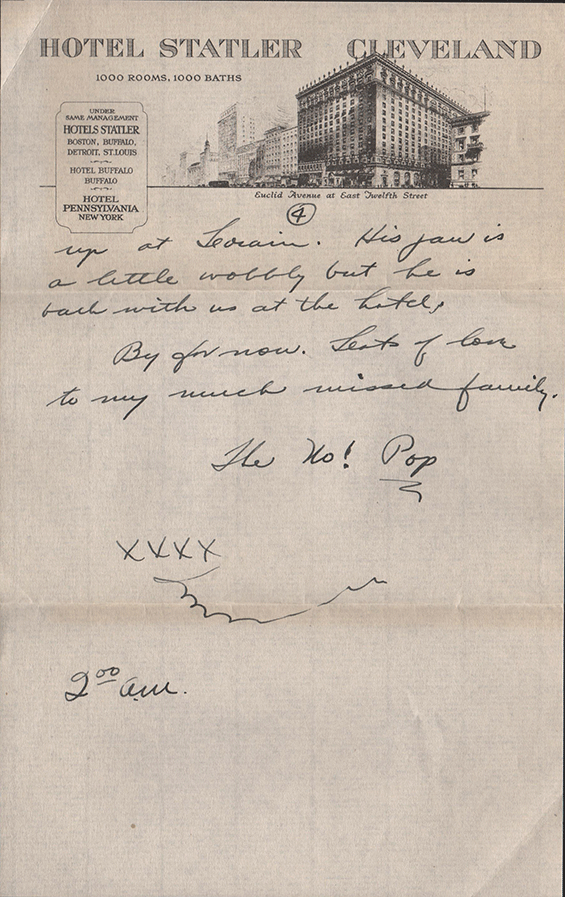 |
The envelope containing this letter is below. This might not be the envelope the letter was mailed in. Note the date, which is cut off, looks like August 13.
Emile Chourré, Letter to Family, Envelope (Source: GL)
 |
Besides this interesting letter, the images and other artifacts of Chourré's Collection are made available to us courtesy of site visitor Gordon Lueckenotte (right sidebar, identified as GL in the image captions). Thanks to him for sharing these important artifacts, which document the business and human sides of one of the largest military logistical maneuvers to pass through Tucson and be recorded in the airfield Register.
Below, from one scrapbook in the Collection, is a route map of all the stops made by the squadron as they made their way to Cleveland and back to San Diego. Note that this route map is titled "Route of 1-J-21." 1-J-21 was the squadron designation of the airplane flown by Chourré (the Sikorsky A-8090).
San Diego to Cleveland Route Map, August, 1929 (Source: GL)
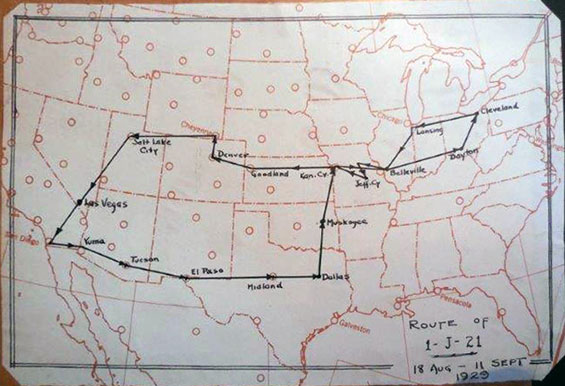 |
Notice the high-altitude experience that was provided by Lt. Commander Wick between Denver and San Diego during his squadron's return flights. Below, the hand-written frontispiece from Chourré's scrapbook. Note the "Press" pass sticker attached. Perhaps Chourré was tasked officially with the job of photographing and documenting the trip for the squadron. At the Wick link, above, you'll find several passages from the Bureau of Aeronautics Newsletter, September 11, 1929, which may have been penned by Chourré.
Frontispiece, NAR Scrapbook, August 18-September 11, 1929 (Source: GL)
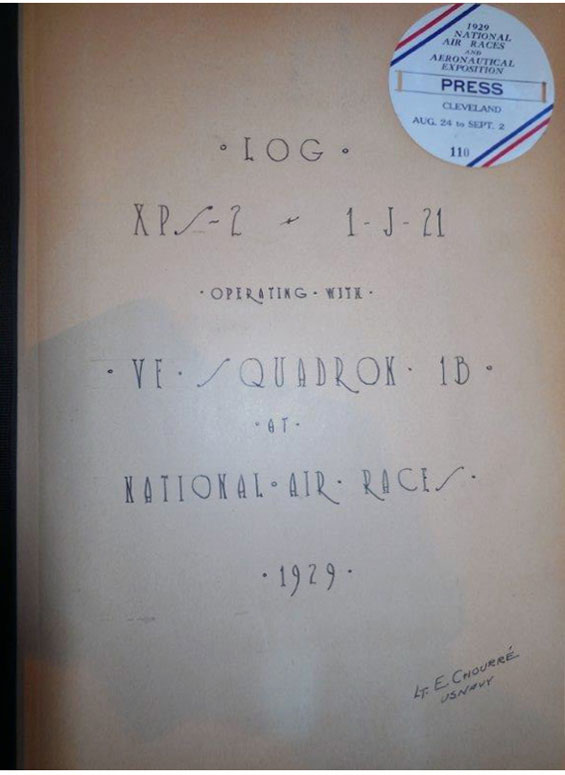 |
Chourré's second landing at Tucson was a year later, on Monday, August 18, 1930 at noon. He carried as copilot J.M. Frosio. They were flying the Sikorsky they identified as N11-4. However, from the scrapbook kept by Chourré that documented the 1930 NAR, a photograph identifies the airplane as A-8285, a Sikorsky PS-3. They carried five passengers identified as Piper, Houser, Born, Gabriel and Stepp. Based at San Diego, they were eastbound to Chicago, IL. The NAR were held at Curtiss-Reynolds Airport this year from August 23-September 1, but there were no other Navy aircraft accompanying him to Chicago (there were three Navy aircraft that landed the same day, but they were westbound from Midland, TX to San Diego). I am only able to make a connection between his flight and the NAR through his scrapbook maintained for the 1930 NAR. Another feature of the memorabilia shared with us by GL is the set of pilot logs maintained by Chourré, below.
Pilot Log Books, Emile Chourré (Source: GL)
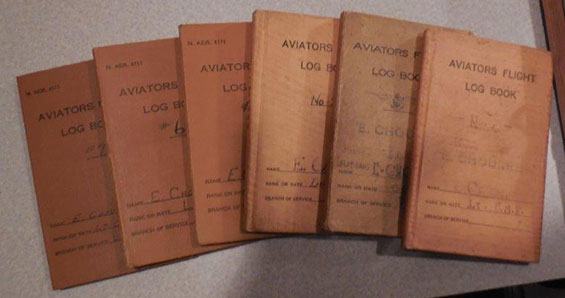 |
Unfortunately, the pilot log that would cover the period of August, 1930 is missing from the collection. If you know where the missing log is, please let me KNOW.
Emile Chourré Masonic Identification Card, 1920 (Source: ancestry.com)
 |
As mentioned earlier, Lieutenant Chourré, USNR, was born August 28, 1894 in San Francisco. As such, he and Wick were the oldest personnel on the cross-country flight. Chourré was designated Naval Aviator #1591 in 1918. Socially, he was a Mason from about 1920 on. He was a member of the Sojourners Lodge, and carried the membership card at left while on assignment at Coco Solo, Panama Canal Zone. His assignment there was documented by him in a SCRAPBOOK from his Collection you can explore at the link.
He accepted several USN commissions following WWI. He rose steadily in the ranks (see below). The New York Times of August 25, 1934 cited him as being promoted from lieutenant to lieutenant commander.
The New York Times, January 27, 1938 (Source: NYT)
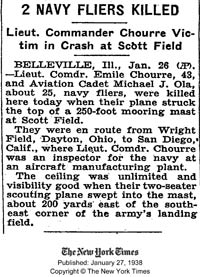 |
I have seen an undocumented suggestion that he was involved during the early 1930s with an Alaskan Aerial Survey Expedition. About the only connection I can find is that he was the artist who drew the logo for the Expedition's aircraft, a winged seal. He was not among the pilots or crew who flew the mission.
About nine years after his visits at Tucson, then Lt. Commander Chourré, USN was killed in a plane crash at the U.S. Army Air Corps' Scott Field, Belleville, IL (east of St. Louis, MO; photographs at the link) on January 26, 1938. He was cremated and his ashes scattered over the Pacific Ocean west of San Diego.
The New York Times of January 27, 1938, right, documented his death. Ironically, the dirigible operation at Scott Field was dismantled later in 1938. If you direct your browser to the St. Louis link above, you will see two views of the dirigible hangar taken a month apart in September and October, 1938. No sign of the mooring mast is visible in either photo.
The official entry in the U.S. Navy Casualties Book for 1938 is below. Choureé was on a ferry trip carrying a single passenger, Michael J. Ola. His flight to Belleville was documented in his flight log book number seven. Please direct your browser to the link, download Choureé's log book seven, and examine page 18 to review that documentation.
1938 U.S. Navy Casualties Book (Source: ancestry.com)
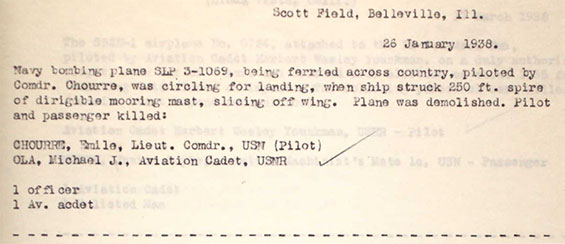 |
Curtiss Seagull, SOC-1 Model, Ca. 1935 (Source: Link)
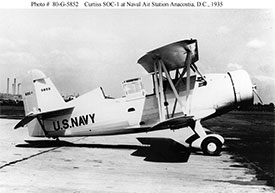 |
Their aircraft was a Curtiss SOC-3 Seagull, a two-place tandem biplane used for observation or bombing missions. It could operate off water with pontoons installed, or off land or carrier decks on wheels. At left is a photograph from 1935 of an SOC-1 on wheels.The Seagull was later, during WWII, superceded by the monoplane Kingfisher.
A chronological listing of Chourré's Navy commissions is included at The Emile Chourré Photograph & Document Collection, DOCUMENTS section at the link. Included are images of all his formal Presidential commissions. He had served four presidents and received commissions from Woodrow Wilson, Warren Harding and Franklin Roosevelt. Perhaps that is a record of sorts.
Immediately below is an image of his Naval Aviator certificate dated November 1, 1918. The small photograph tucked in his certificate appears to be a later likeness.
Emile Chourré Naval Aviator Certificate, November 1, 1918 (Source: GL)
 |
A few weeks after he earned his Naval Aviator status, he acquired a Fédération Aéronautique Internationale license, number 270. That license is shown below, bearing the same photograph as his Naval Aviator certificate.
Emile Chourré FAI License, November 20, 1918 (Source: GL)
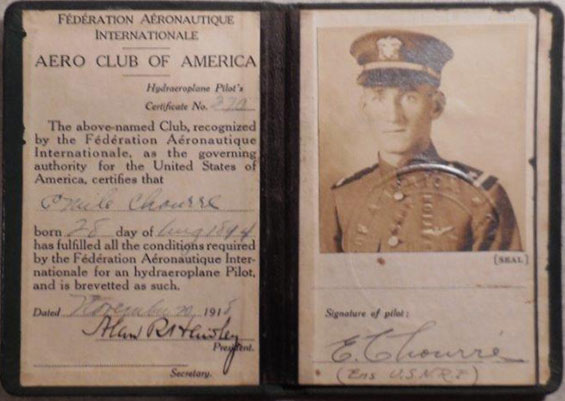 |
Incident to his residence at the orphan home in Gilroy, CA, an online report containing historical anecdotes about the home celebrated Chourré as follows.
"Emile Chourré went to live in the IOOF Home at Gilroy, California in 1902 and
stayed there until he graduated from Gilroy High School in 1912. He was active in track,
football, rugby, and assistant editor of the yearbook. Upon graduation he went to the
University of California at Berkeley. Then transferred to Santa Barbara State where he
graduated as a teacher in Manual Training. He was employed as a teacher at Alameda High
School in 1917.
"In 1918, Emile enlisted in the Navy. He went to school and won his wings as a
Navy pilot. He started his navy career in Miami in 1918. Then he was transferred in 1919
to the air station in San Diego and earned the distinction of being one of the pioneers in
Naval Aviation.
"In 1922, the coal carrying ship the Jupiter was converted to the first aircraft carrier
called the USS Langley. Emile transferred from land-based airplanes to the carrier Langley
for duty. He soon became the flight deck officer. After many years of carrier duty he was
transferred to the Naval Air Station as engineering officer in San Diego. He was one of the
youngest flyers to attain the rank of Flight Lieutenant Commander.
"Emile participated in the National Air Races, held in Los Angeles from September
10 to 16, 1928, as a Navy pilot [the Aircraft Yearbook for 1929 makes no mention of Chourré participating in any event; not surprising, given that he was flying a transport supply craft for the entourage, and serving as the master of ceremonies for the naval aerobatic team]. The air races in 1934 and 1935 were held in Cleveland, Ohio. Because of his knowledge of all types of Naval airplanes, the Navy Department assigned him to act as the announcer and commentator at the National Air Races [The New York Times of August 31, 1931 carried an article with an example of Chourré's commentating]. He served aboard the aircraft carrier the USS Saratoga for a time. In 1936, he became the Naval Inspector at the Consolidated Aircraft Corporation located at Lindbergh Field, San Diego.
"Lt. Commander Emile Chourré and a flying cadet Michael Ola were ferrying an
airplane from Dayton, Ohio, back to San Diego in January 1938. They were in the process
of landing for fuel at Scott Field, Belleville, Illinois, on January 26th. The visibility was
ten miles and a strong wind was blowing making a landing impossible except for flying
over the hanger. Their Naval scout plane struck an unused dirigible mooring mast that
stood two hundred and fifty feet in the air. The mast had been used by lighter-than aircraft
years before. The impact sheared off the right wing, and the wreckage fell to the ground
two hundred yards from the mast. Both men died in the accident [article, above]. Emile's body was brought back to San Diego, California, for burial [actually, he was cremated and his ashes were scattered at sea].
"In 1945, the Navy named one of their new ships the USS Chourré in his honor
for his contribution to the advancement of Naval aviation."
|
Indeed, during World War II, the aircraft repair ship U.S.S. Chourré (ARV-1) was named in his honor. It was launched May 22, 1944 after a construction cost of $1,684,195.17. Two views of the Chourré are below. The views are from the link.
U.S.S. Chourré, Date & Location Unknown (Source: Web)
 |
The Chourré was one of the famous Liberty Ships. Appendix 12 of this REFERENCE, pp. 601-606, contains a list of naval ships named after naval aviators. The Chourré is found on page 602.
U.S.S. Chourré, Date & Location Unknown (Source: Web)
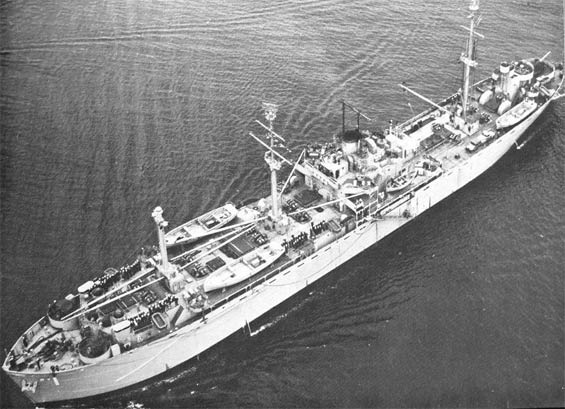 |
Having earned his wings before WWI Armistice on November 11, 1918, Chourré is a founding member of the Order of Daedalians.
---o0o---
Dossier 2.2.198
THIS PAGE UPLOADED: 02/11/12 REVISED: 11/19/14, 06/01/15, 11/20/15
|

